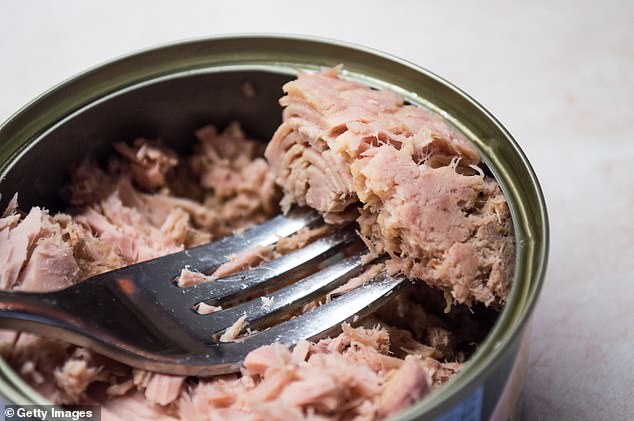Concerns were raised earlier this week about the safety of canned tuna, after tests on 150 cans purchased in five countries found that half contained more than the recommended amount of the toxin mercury.
The study, by French researchers, found that all cans studied, including some purchased in the UK, contained some of the metal which, in large quantities, can damage brain health and has been linked to cancer.
In fact, the NHS advises pregnant women to eat no more than two tuna steaks or four cans a week due to the risk of damaging the unborn baby’s brain.
And it’s not just tuna that contains mercury; In fact, all fish do, and some types, such as swordfish, contain especially large amounts.
So how much is safe for us to eat?
First of all, whether the fish is canned or not doesn’t matter much.
Most of the mercury released into the atmosphere from natural and human causes, such as burning coal, ends up in the ocean, where some is converted by tiny organisms into a toxic compound known as methylmercury.
This methylmercury moves up the food chain and accumulates in high concentrations in top predators.
But for just 65p a can, tuna can offer an affordable source of protein, healthy fats and vitamin D.
Because tuna (and other predators or longer-lived species, such as sharks or swordfish) are higher up the food chain, they eat smaller fish and accumulate more mercury over time.
Exposure to methylmercury can damage the kidneys and nervous system, cause vision problems, and increase the risk of cardiovascular disease.
According to the World Health Organization, mercury can also cause neurological and behavioral disorders if inhaled, ingested, or if it comes into contact with the skin.
Symptoms include tremors, insomnia, memory loss, headaches, and cognitive and motor dysfunction.
Studies have shown that at very high doses, some forms of mercury have caused the development of various types of tumors in rats and mice.
But the International Agency for Research on Cancer (IARC) found that there was not enough evidence to determine whether mercury could cause cancer in humans.
The NHS advises people to eat at least two portions of fish a week to reap its nutritional benefits, such as protection against heart disease and bone-boosting vitamin D.
Studies have shown that the average person is unlikely to consume enough mercury through fish to cause serious harm.
Laboratory tests conducted for ABC TV’s science show Catalyst in 2015 revealed that you would have to eat at least 25 cans of tuna a week before reaching the amount that studies have shown is harmful.
This is equivalent to about 16 140g tuna steaks.
Scientists from the Australian government agency, the Commonwealth Scientific and Industrial Research Organization (CSIRO), which conducted the study, wrote in it Conversation The exact amount depends on the brand of tuna and the weight of the person.
For example, Skipjack varieties are said to have less mercury than albacore tuna.
They stressed that even the worst brand they tested was “not that bad” and said consumers were unlikely to meet the upper safety limits.
Under current EU and UK laws, the limit for mercury in tuna is 1 mg/kg and 0.3 mg/kg for other fish such as cod.
By comparison, canned salmon has much lower levels of mercury, averaging 0.05 micrograms of mercury per gram, according to the Global Salmon Initiative.
Rob Hobson, registered nutritionist and author of Unprocessed: Your Family Life, told MailOnline Eating “light tuna” two or three times a week is safe and also encourages people to consume a variety of fish.
“Research suggests that light and skipjack tuna have less mercury than larger species such as bigeye and albacore tuna,” he said.
‘FDA advice in the US is to limit tuna intake to two to three servings per week and choose light (skipjack) tuna varieties.
Meanwhile, the NHS says some white fish, such as cod, can be eaten as much as you like due to extremely low levels of mercury.
However, other white fish contain mercury and other contaminants and should be limited to a few times a week. This includes sea bream, sea bass, turbot, halibut and rock salmon.
Pregnant women and children are particularly vulnerable to high levels of methylmercury, according to the World Health Organization (WHO).
You should not eat shark, swordfish or marlin if you are pregnant or trying to get pregnant, adds the NHS. But all other adults, including breastfeeding women, should eat no more than one serving per week.
This is because these fish may contain more mercury than other types of fish and may harm a developing baby’s nervous system.
The FSA told MailOnline: ‘Mercury is found in all fish as a result of a natural build-up in the environment, so it cannot be completely removed.
‘Instead, we aim to keep levels as low as possible. Large, long-lived predatory fish (sharks, for example) have the highest levels of mercury.
‘In Britain we have a maximum level of mercury in tuna of 1.0 mg/kg.
“Importers and food business operators have a responsibility to ensure that the food they market is safe for human consumption and will carry out testing themselves to ensure compliance.”


